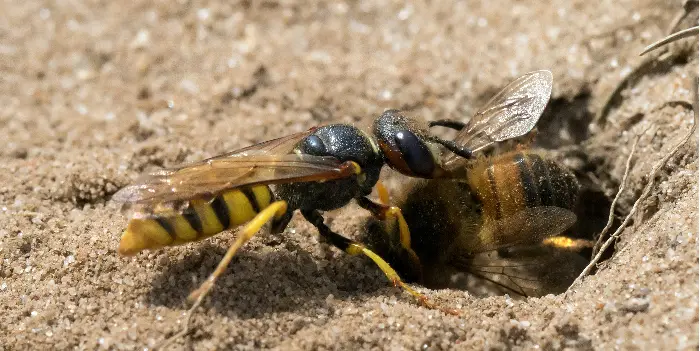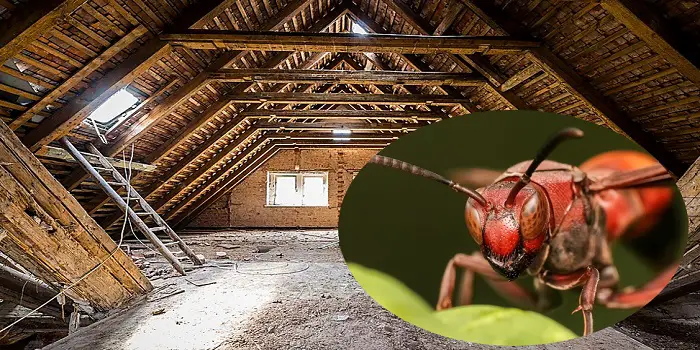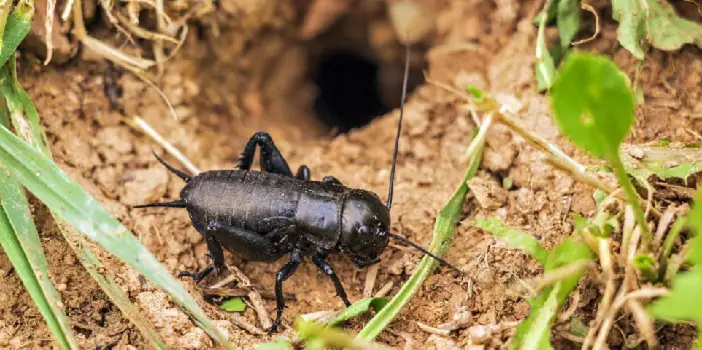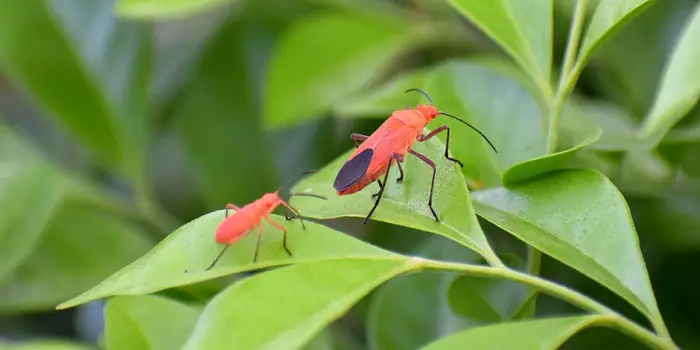
The boxelder bug gets its name from the boxelder tree, of which the insect is often found on or nearby.
The bug itself ranges from eastern Canada down to the eastern US and across to Nevada.
Wherever there are boxelder trees, you can bet that the boxelder bug is nearby.
However, while the boxelder bug is fairly harmless when on the boxelder tree, it can make its way into homes, garages, and sheds and become quite a nuisance.
Appearance
A typical adult boxelder bug is black with either orange or red markings on its back.
About ½” long, the bug is shaped like an elongate oval that is flat. They have six legs and two antennae.
The nymph stage is similar to the adult, but they tend to be bright red in color and do not have wings.
As with most insects, the boxelder bug will hibernate during the winter, emerge during the spring, and spend most of its time feeding on the host trees until fall.
Food and Habits
The primary food source of the boxelder bug is the seeds and young leaves of the boxelder tree.
They feed by sucking sap from the leaves, tender twigs, and tiny seeds that are yet in a developing stage.
The good thing is they do not siphon the fluid out of leaves and plants in significant quantities that will completely damage them.
So, they are not very dangerous to the plants and trees they thrive on.
Occasionally, you may see the bug feeding on the fruit of apple or plum trees.
But if a boxelder tree is around, then they usually stick to that.
During the fall, the boxelder bugs will gather in areas where it is sunny, such as on the trees, rocks, and even buildings if they are nearby.
Once they gather into a large swarm, they will seek shelter for the winter so they can hibernate.
This is when they come into homes and buildings since they are heated and provide a safe place to stay.
Issues with Boxelder Bugs
A boxelder bug will not bite, but parts of its mouth are strong enough to puncture the skin.
If you crush one, it will give off a strong odor that is most unpleasant.
They can also stain fabric with their feces.
This may leave behind a red or orange stain which must be cleaned.
The main issue with boxelder bugs is their numbers.
They can be most annoying when they gather inside the home. Getting rid of them usually means using pesticides or other deterrents.
What Attracts Boxelder Bugs to Your Home?
Boxelder bugs are found in most states east of the Rocky Mountains.
They are most commonly found along major rivers such as the Mississippi, Missouri, and Ohio.
But why do boxelder bugs like your house?
Keep in mind that it is the warmth and protection of your home and not necessarily the food available inside that make it quite attractive to this bug.
You may notice them on the south side of your home first as they gather under the warm sunlight.
The heat that is reflected off your home will draw them inside.
Once inside, the bugs will then find the crevices and cracks that make the perfect nesting area.
And, at some point during the winter, the eggs they have laid will hatch.
And when spring arrives, you will see an even larger number of boxelder bugs inside your home.
Different Methods of Getting Rid of Boxelder Bugs
There is no singular method of getting rid of boxelder bugs that is perfect.
Every commonly used method will have its advantages and disadvantages.
So, you will have to choose one or more that best suits your needs while minimizing the danger or damage to your home.
1- Remove Boxelder Trees
The reason why they are called boxelder bugs is that they thrive on boxelder trees.
By removing the trees from within 100 feet of your home, you significantly reduce the chances that boxelder bugs will find your residence.
Boxelder trees are not that desirable to have near your home as the root system is often not strong enough to withstand a good windstorm.
So, you are doing yourself and your pocketbook a favor by getting rid of such trees.
However, boxelder bugs are known to be around maple trees.
So, it does pay to inspect all the trees around your home for any signs of boxelder bugs.
You don’t have to cut down such trees, but you can use insecticides or other products to reduce the number of bugs.
2- Seal the Home
Check the windows and doors for any openings or cracks which might allow the boxelder to bug inside.
After all, if they cannot get in, then you do not have to get rid of them.
However, even small cracks may be enough to allow them to burrow inside.
Once you have identified a crack, seal it up using window caulk.
This type of caulk will stop the entry of boxelder bugs and many other types of insects as well.
It is safe to use and harmless to pets and children.
However, it may not be possible to spot all cracks or openings in your home, so you’ll need to be prepared if you see bugs inside.
3- Use Dish Soap
Before entering your home, boxelder bugs are often seen on trees or warm surfaces.
You can mix one-part dish soap with four parts of water and put the contents in a spray bottle.
When you see the bugs, spray them with the mixture.
The dish soap itself is relatively harmless to humans, pets, and even the grass.
Plus, it will not harm surfaces and may help to clean them.
The boxelder bugs themselves will die fairly quickly.
The dish soap stuns and then kills the boxelder bugs, making the dish soap mixture a good, safe method of getting rid of the bugs.
The only downside is that you have to see the bugs first in order to spray them.
This may mean dozens, if not hundreds, of boxelder bugs, are still inside your home.
4- Spray Insecticide
There are potent insecticides that will kill the boxelder bug quickly and efficiently.
Plus, you can find products tailored to destroy stink bugs and boxelder bugs.
And while both insects are somewhat different, they have the same vulnerabilities.
The active ingredients in the insecticide will not only kill the bugs on direct contact the residue will continue to kill the bugs for days or even weeks at a time.
Windows, doorways, and the foundation are the best places to use the insecticide.
Just spray every few days and judge the results.
Of course, the big downside is that insecticides use poisonous chemicals on insects, pets, and humans.
If you do not have pets or children, this may be a good way to rid your home of bugs.
5- Vacuum the Bugs
Your vacuum with the handy hose attachment is a great way to suck up the bugs when you see them.
The bugs themselves are not all that fast, and you can reduce their numbers without using any chemicals.
Have your vacuum at the ready so it can be used when you spot a bug.
You may even try using a dust buster, a small handheld vacuum that you can keep with you.
Vacuuming is safe, effective, and does not leave behind any harmful residue.
However, you are not solving the issue as there are far more bugs crawling around than you are seeing.
But it will reduce their numbers, so that is a positive.
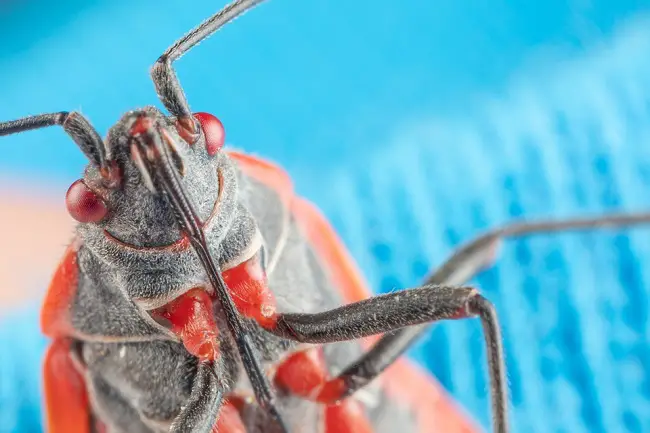
Are Boxelder Bugs Harmful?
If you find boxelder bugs in your home, the first question you may ask is whether these bugs represent a danger to you, your family, pets, or the home itself.
The answer is no.
Boxelder bugs do not carry diseases or viruses that may be harmful to you or your pets.
There have been reported cases of dogs or cats eating a boxelder bug and then vomiting the remains.
But since the bugs themselves are not poisonous, it only means that they upset the stomach when present.
Furthermore, they do not bite. So, the only thing that boxelder bugs are when inside the home is being quite annoying.
They may slightly damage some of the plants and small trees you may keep inside the home.
But the damage they cause is nothing compared to more insidious bugs such as the emerald ash borer or bark beetle.
However, if you do have a large number of boxelder bugs in your home, they may congregate on your plants and possibly stunt their growth.
When Do Boxelder Bugs Invade the Home?
As mentioned earlier, boxelder bugs tend to invade your home during the spring and fall.
When the winter thaw arrives and the temperatures warm, you may see boxelder bugs looking for food or potential mates.
There is no set date when the boxelder bugs will start arriving, but the first warm day of the year is often when you see them as they awaken from their hibernation.
However, it is quite possible that the bugs have been in your home for quite some time.
This means that in the spring, the boxelder bugs you see were hatched sometime during the winter months.
The fall is the second time of the year when you start noticing the bugs.
This is because they are looking for a safe place to either hibernate or a warm area to stay.
As with the arrival of spring, there is no set date on which the boxelder bugs will suddenly become more active.
However, it will most likely occur after the first cool day of the fall.
At that point, you will notice an increase in the number of bugs as they are searching for a warm place to stay.
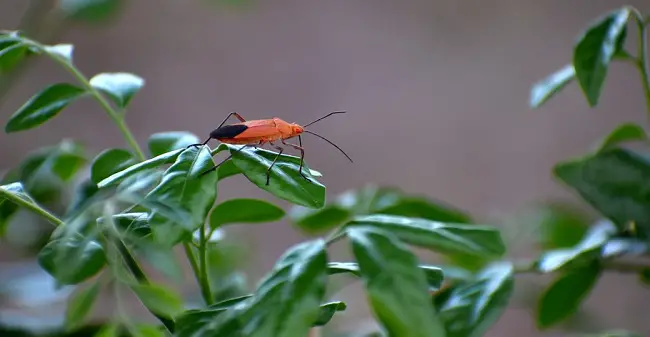
Are Boxelder Bugs the Same as Stink Bugs or Different?
Boxelder bugs are different than stink bugs, although they do have many similarities.
Both like to get inside homes, lay plenty of eggs, and will be noticed most often in the spring and fall.
Stink bugs are not as colorful as boxelder bugs and tend to be grey with shorter bodies.
A boxelder bug is long, slender, and has a red to orange accent to its coloring.
The biggest difference is the overall size, as stink bugs tend to be twice as big as boxelder bugs.
The most obvious difference is that a stink bug will generate a pungent odor as a defense when threatened, while a boxelder bug will not.
Stink bugs may also bite, but only rarely and possibly accidentally.
Both bugs are harmless to humans and pets, but they can be quite annoying.
The stink bug is most often found in the northeastern US, particularly the Mid-Atlantic states.
They can also be found in the Pacific Northwest.
This means they are more limited in range compared to the boxelder bug but may still be found in small numbers in most parts of the country.
Other Related Questions:
What do boxelder bugs smell like?
Boxelder bugs are good at discouraging predators from coming near to them and plants.
And they do so by releasing bad-smelling/tasting chemicals (pheromones).
They do not emit this foul-smelling liquid during their normal activities.
But the pungent compound is usually secreted by boxelder bugs when you try to disturb, smash or crush them.
Can you use a trap for box elder bugs?
Boxelder bugs are the creepers that can often hide and hang out in your basement, attic, or near the ceilings.
To catch them, you can place a light insect trap where they are usually seen inside your home.
These traps usually use glue or light to lure and ensnare the bugs.
To catch boxelder bugs alive, you can also make a homemade trap with the help of cardboard and petroleum jelly (or double-sided tape).
Lay the sticky trap around and they will automatically trap the bugs for you.
Are there any plants that repel boxelder bugs?
Box elder bugs are attracted to many trees and plants.
But there are certain plants that you can use to your advantage to deter these bugs from your yard.
Some common plants to prevent box elder bugs include chrysanthemum flowers, sage, lavender, and garlic.
These box elder bugs repelling plants can be grown inside your garden near the trees that attract the bugs most.
The Conclusion
Although most boxelder bugs are not dangerous and live outside your home, the temptation to move inside can be quite strong.
This is especially true in the spring and fall months.
The boxelder bug is no different as they want to enter and live inside your home.
During the cooler months of fall, if the bug finds the warmth of your home quite attractive, just follow the above guidelines and tips.
And I hope these can surely help you deal with the problem.
Share the post "What are Boxelder Bugs – How to Keep Them Out of House?"

Welcome to ProShieldPest.com. I am Tina Jones. I have been working as a pest removal professional in Winslow, Arizona lately. At present, I love to spend my time with my family as a retiree.
Here I share all my knowledge and experiences to help people understand better how they can stop pests at their homes without actually killing them. Hopefully, the information you will find here will help in safeguarding your home! You can check more about me here.


